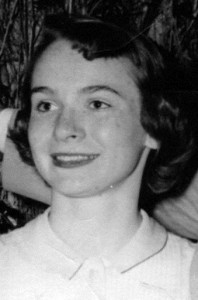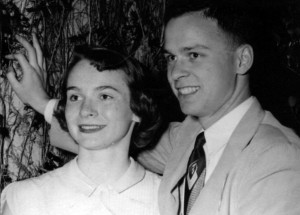Ann Phillips (Cooper) ’48

I remember the excitement of someone’s parents getting a new car! New cars were not available from 1942 to 1946, and the waiting lists were long. My parents didn’t get one until 1950. Generally our transportation for dating was streetcars and busses.
Every month or so a school social committee would decorate the girls’ gym for a school dance. Sometimes we danced to records; special dances had a band. The best band of our era was that of Dick Luciani, who later changed his name to Lane, played at Lake Tahoe and the last I heard of him he was an events coordinator or something similar in Las Vegas. I think he was in the class of 1947.

In terms of outstanding teachers, two young women fit the description. Virginia Jones was a tall, pretty redhead who taught history, and the boys liked to be in her class just to look at her. She WAS a good teacher. The other was Sally Rinehard, the drama teacher about whom the boys waggled their eyebrows and rolled their eyes. Miss Rinehard was also a good teacher. She had even been to Pasadena Playhouse. All of the other teachers were older, but three stand out for me. One was Jessie Smith, about whom John has written. The other two are Anga Bjornson and Talcott Williamson. Miss Bjornson taught US History to juniors and seniors. She was a self acknowledged Socialist and she told us why. She voted the Democratic ticket because it best represented the socialist goals. She was honest and fairly gave time for other views. Since my family was very conservative politically, I learned for the first time that people who disagreed with my family were not all stupid or evil. The last I saw of Miss Bjonsen was in the centerfold of TIME, with others at a Democratic Convention in Florida, wearing a big smile and a straw skimmer with a band that said HUMPHREY.
Talcott Williamson is someone about whom I knew something before I ever heard his name. When I was still commuting from Piedmont Hi, I would take the streetcar to Piedmont Avenue to transfer to the bus for Montclair. The Terminal was across the street from Pinkie’s Bar and nearly every day a yellow Ford convertible was parked within the block. It belonged to Mr. Williamson. I had the privilege of being in his “Senior Problems” class, a general discussion group of 30 or more. He would start a topic and we would unload¬ opinions only, and no homework that I remember. He called on us and asked for alternate responses. His topics were situations we should expect to find in our adult lives, and the discussions were about how we expected to deal with them. I wish everyone could experience such a class with such a superb guide.
Another one of his classes was “boys-only.” Early in the day the door to his classroom would be locked, the windows cracked open, and the cigarette smoke would pour out to the extent that at least twice, over the years, the Fire Department was called. The boys in the class were called “at risk.” They were starting to get into trouble with the police, or their families were involved with the police and were abusive, physically and/or sexually or were drug addicts or alcoholics or were inclined toward violence… you name it. Mr. Williamson’s goal was to keep them in school to graduate so that they could have a chance at a good job and a decent life. Years later John and I would read in the newspaper that an award was given by a civic organization to someone who had done something new to improve life in Oakland, not just by adding money to support an existing cause, but for innovation. In the years we were aware of this annual honor, one out of three recipients answered the question, “What inspired you…” with, “Well, I was one of Mr. Williamson’s boys…” By the way, Talcott Williamson was head of the English Department at Tech and had been mentor and guide to Thornton Wilder (the author of the famous play “Our Town.”) With a Master’s Degree in Child Psychology, he had come to Tech Hi from New England to be a part of the experimental school where social classes were mixed. Tech was nationally known for its advanced planning.
Tech Hi opened the world for me: I continue to look for variety in life, lives, experiences, reasons viewpoints, etc. and Tech Hi gave me a really solid start.
My husband and I are both part of the class of 1948. Four of our wedding party (1951) were Technites, three of them still alive and in touch. We are probably in easy reach of a dozen more…actually more.
My advice to current Tech students: pick your teacher’s brain. Do not interrupt or challenge, but show an interest in SOMETHING when it is convenient for the teacher. You’ll be surprised at the fascinating things you’ll learn
John and I have been married for 63 years and have 4 children, all well. That is the 2-sentence summary of my fortunate life. From 1962 to 1967 John worked in Washington DC. We attended the Kennedy funeral parades, were acquainted with some legislators, and our older children were schoolmates of the children of others. It was a most interesting time. One of my memorable experiences was phoning a Senator whom I’d not met, and apologizing for my 5th grade son beating up his 5th grade son and sending him home in tears. I was terrified that John’s job might be endangered. I am glad to say that Senator Gaylord Nelson from Wisconsin, who invented Earth Day, was one of the nicest men on the planet!
In 1969, John ran for School Board in the Richmond Unified District (now I believe it is West Contra Costa). The big issues were taxes and integration. John lost, but in the campaign we associated with people from the very conservative to the Black Panthers. It was rather like being back at Tech Hi, which John mentioned often in his campaign. It all started with Tech Hi.
One last memory: 1947, the auditorium, a morning assembly. On stage are two actors, Mel Silverman (1947) and Kenny Snyder (1948) in renaissance costumes and make-up……velvet bloomers, big floppy hats, ostrich plumes…… a portion of one of the “Thus , … I die…” scenes. Mel lies down, hat on abdomen, rising frequently for another “last word” and Kenny, arm reaching to the audience, orating….. The ostrich feather on Mel’s hat aims at Mel’s face. There are a few snickers in the audience. Kenny glances down and begins to convulse. Mel opens an eye, starts a helpless chuckle and the whole audience explodes. You can see a picture of Mel in some of the costume at the top, center of the last page of pictures in the June, 1947 yearbook.
